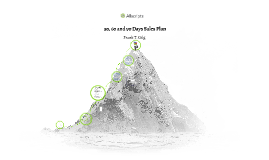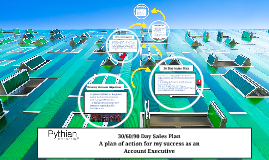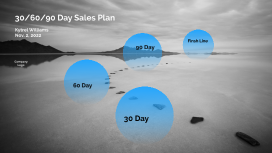30 60 90 Day Sales Plan
Transcript: 30 60 90 Day Sales Plan A Guide for New Enterprise Sales Rep Tracking Progress and Results Importance of the First 30 Days Overview of the 30-60-90 Day Plan Monitoring and Evaluation Action Steps: Achieving Sales Goals Regularly monitoring key metrics like leads generated, sales meetings held, and revenue generated is essential to gauge the effectiveness of the sales plan. Utilize CRM tools to track and analyze progress accurately. Goals and Strategies The initial 30 days focus on learning the company's products, services, and sales processes to hit the ground running. The 30-60-90 Day Plan outlines specific tasks and goals for new enterprise sales representatives over the first three months. Adjusting Strategies Based on Performance Utilize CRM Tools for Tracking First 30 Days: Specific Tasks Final 90 Days: Celebrate Success Tracking progress and adapting sales tactics are crucial for success in the 30-60-90 Day Sales Plan. Analyze the results obtained in each phase to identify what strategies are working and what needs adjustment. Flexibility and adaptability in approach are key to optimizing performance and achieving sales goals effectively. Implementing a Customer Relationship Management (CRM) system enables sales reps to track customer interactions, manage leads efficiently, and analyze sales data for informed decision-making. This section focuses on specific tasks for the first 30 days, implementation plan for the next 60 days, and long-term goals for the final 90 days of the sales plan. Build relationships with stakeholders Familiarize with products Understand sales process Acknowledge team efforts Celebrate milestones Motivate for future goals Setting Targets for the First 30 Days Introduction to Sales Plan Data-Driven Decision-Making Performance Metrics Dashboard Evaluation and Reflection New enterprise sales reps at Simplista set targets for each phase and develop strategies to achieve sales goals effectively. During the initial 30 days, the focus is on building connections, understanding the product, and prospecting potential clients. Make data-driven decisions by analyzing sales trends, customer preferences, and performance metrics. Utilize data analytics tools to derive insights and optimize sales strategies for improved results. Develop a performance metrics dashboard to visualize key performance indicators, track progress towards sales goals, and identify areas for improvement and strategic adjustments. Reflect on the effectiveness of the 30-60-90 Day Sales Plan, evaluate outcomes against set goals, and iterate on strategies to drive continuous improvement and future success. Final 90 Days: Closing Remarks Final 90 Days: Key Takeaways First 30 Days: Set Objectives Initial meetings with sales team Align on objectives and goals Review key learnings Plan for ongoing success Set new goals for continued growth Summarize achievements Highlight key takeaways Plan for future success Continuous Improvement Culture Performance Review Meetings Cultivate a culture of continuous improvement within the sales team by encouraging feedback, fostering learning opportunities, and promoting collaboration for shared success. Conduct regular performance review meetings to assess individual and team progress, discuss challenges, and align strategies for achieving sales targets effectively. Unlock the potential of the 30-60-90 Day Plan. Effective enterprise sales start with a structured sales plan. Enhancing Sales Strategies for 90-Day Plan Final 90 Days: Sustainable Growth Final 90 Days: Evaluate and Adjust Next 60 Days: Implementation Plan In the final phase, emphasis is on solidifying long-term client relationships, maximizing sales opportunities, and strategizing for continued growth within the enterprise sales role. Focus on continuous improvement Drive sustainable growth Seek opportunities for expansion Evaluate sales performance Adjust strategies accordingly Focus on continuous improvement Develop lead pipeline Conduct outreach and follow-ups Build industry network Feedback Loop Implementation Establish a feedback loop with customers to gather insights, address their needs effectively, and enhance customer satisfaction. Incorporate feedback into sales strategies to tailor offerings and improve customer experience. Developing Strategies for 60-Day Milestone Strategy Development for the Last 30 Days Significance of the 60-Day Milestone Next 60 Days: Collaborate with Marketing Final 90 Days: Long-term Goals Moving into the 60-day phase, strategies are refined to deepen client relationships, secure initial sales, and expand the customer base through targeted efforts. The final 30 days focus on fine-tuning strategies, maximizing client engagement, and setting the stage for long-term success in enterprise sales. At the 60-day mark, reps should have built strong relationships with clients and made significant progress towards their sales targets. Adapting to Market Changes Enhance lead generation strategies Optimize

















